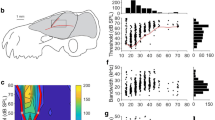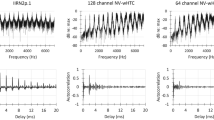Summary
-
1.
The neural audiogram of the common long-eared bat,Plecotus auritus was recorded from the inferior colliculus (IC). The most sensitive best frequency (BF) thresholds for single neurones are below 0 dB SPL between 7–20 kHz, reaching a best value of -20 dB SPL between 12–20 kHz. The lower and upper limits of hearing occur at 3 kHz and 63 kHz, respectively, based on BF thresholds at 80 dB SPL. BF threshold sensitivities are about 10 dB SPL between 25–50 kHz, corresponding to the energy band of the sonar pulse (26–78 kHz). The tonotopic organization of the central nucleus of the IC (ICC) reveals that neurones with BFs below 20 kHz are disproportionately represented, occupying about 30% of ICC volume, occurring in the more rostral and lateral regions of the nucleus.
-
2.
The acoustical gain of the external ear reaches a peak of about 20 dB between 8–20 kHz. The gain of the pinna increases rapidly above 4 kHz, to a peak of about 15 dB at 7–12 kHz. The pinna gain curve is similar to that of a simple, finite length acoustic horn; expected horn gain is calculated from the average dimensions of the pinna.
-
3.
The directional properties of the external ear are based on sound diffraction by the pinna mouth, which, to a first approximation, is equivalent to an elliptical opening due to the elongated shape of the pinna. The spatial receptive field properties for IC neurones are related to the directional properties of the pinna. The position of the acoustic axis of the pinna and the best position (BP) of spatial receptive fields are both about 25° from the midline between 8–30 kHz but approach the midline to 8° at 45 kHz. In elevation, the acoustic axis and the BP of receptive fields move upwards by 20° between 9–25 kHz, remaining stationary for frequencies up to 60 kHz.
-
4.
The extremely high auditory sensitivity shown by the audiogram and the directionality of hearing are discussed in terms of the adaptation of the auditory system to low frequencies and the role of a large pinna inP. auritus. The functional significance of low frequency hearing inP. auritus is discussed in relation to hunting for prey by listening and is compared to other gleaning species.
Similar content being viewed by others
Abbreviations
- BF :
-
best frequency
- BP :
-
best position
- FM :
-
frequency modulation
- IC :
-
inferior colliculus
- ICC :
-
central nucleus of the inferior colliculus
- TM :
-
tympanic membrane
- SPL :
-
sound pressure level
References
Ahlén I (1981) Identification of Scandinavian bats by their sounds. The Swedish University of Agricultural Sciences, Report 6, Uppsala
Barclay RMR, Fenton MB, Tuttle MD, Ryan MJ (1981) Echolocation calls produced byTrachops cirrhosus (Chiroptera: Phyllostomatidae) while hunting for frogs. Can J Zool 59:750–753
Bell GP (1982) Behavioral and ecological aspects of gleaning by a desert insectivorous bat,Antrozous pallidus (Chiroptera: Vespertilionidae). Behav Ecol Sociobiol 10:217–223
Bell GP (1985) The sensory basis of prey location by the California leaf-nosed batMacrotus californiens (Chiroptera: Phyllostomidae). Behav Ecol Sociobiol 16:343–347
Beranek LL (1954) Acoustics. McGraw-Hill, New York
Brown PE, Grinnell AD, Harrison JB (1978) The development of hearing in the pallid bat,Antrozous pallidus. J Comp Physiol 126:169–182
Brown PE, Narins PM, Grinnell AD (1984) Low frequency auditory sensitivity of the pallid batAntrozous pallidus. Am Neurosci Abstr 10:1150
Buchler ER, Childs SB (1981) Orientation to distant sounds by foraging big brown bats (Eptesicus fuscus). Anim Behav 29:428–432
Coles RB, Guppy A (1986) Biophysical aspects of directional hearing in the Tammar wallaby (Macropus eugenii). J Exp Biol 121:371–394
Fiedler J (1979) Prey catching with and without echolocation in the Indian False Vampire (Megaderma lyra). Behav Ecol Sociobiol 6:155–160
Fletcher NH, Thwaites S (1979) Physical models for the analysis of acoustical systems in biology. Q Rev Biophys 12:25–65
Griffin DR (1958) Listening in the dark. Yale University Press, New Haven
Grinnell AD (1963a) The neurophysiology of audition in bats: intensity and frequency parameters. J Physiol 167:38–66
Grinnell AD (1963b) The neurophysiology of audition in bats: directional localization and binaural interaction. J Physiol 167:97–113
Grinnell AD, Grinnell VS (1965) Neural correlates of vertical localization by echo-locating bats. J Physiol 181:830–851
Guppy A, Coles RB (1988a) Acoustical and neural aspects of hearing in the gleaning batsMacroderma gigas andNyctophilus gouldi. J Comp Physiol A 162:653–668
Guppy A, Coles RB (1988b) Acoustical aspects of hearing and echolocation in bats. In: Nachtigall PE, Moore PWB (eds) Animal sonar: processes and performance, vol 156. Plenum Press, New York, pp 289–294
Guppy A, Coles RB, Pettigrew JD (1985) Echolocation and acoustic communication signals in the Australian ghost bat (Macroderma gigas). Aust J Mammal 8:299–308
Konishi M (1973) How the owl tracks its prey. Am Sci 61:414–424
Leonard ML, Fenton MB (1984) Echolocation calls ofEuderma maculatum (Vespertilionidae): use in orientation and communication. J Mammal 65:122–126
Marimuthu G, Neuweiler G (1987) The use of acoustical cues for prey detection by the Indian false vampire bat,Megaderma lyra. J Comp Physiol A 160:509–515
Neuweiler G (1983) Echolocation and adaptivity to ecological constraints. In: Huber F, Markl H (eds) Neuroethology and behavioural physiology. Springer, Berlin Heidelberg New York, pp 280–302
Neuweiler G (1984) Foraging, echolocation and audition in bats. Naturwissenschaften 71:446–455
Neuweiler G, Singh S, Sripathi K (1984) Audiograms of a south Indian bat community. J Comp Physiol A 154:133–142
Payne RS (1971) Acoustic location of prey by barn owls (Tyto alba). J Exp Biol 54:535–573
Poussin C, Simmons JA (1982) Low-frequency hearing sensitivity in the echolocating bat,Eptesicus fuscus. J Acoust Soc Am 72:340–342
Ryan MJ, Tuttle MD (1987) The role of prey-generated sounds, vision, and echolocation in prey localization by the African batCardioderma cor (Megadermatidae). J Comp Physiol A 161:59–66
Ryan MJ, Tuttle MD, Barclay RMR (1983) Behavioral responses of the frog-eating bat,Trachops cirrhosus, to sonic frequencies. J Comp Physiol 150:413–418
Ryan MJ, Tuttle MD, Rand AS (1982) Bat predation and sexual advertizement in a neotropical anuran. Am Nat 119:136–139
Schmidt S, Türke B, Vogler B (1984) Behavioural audiogram from the batMegaderma lyra (Geoffrey, 1810; Microchiroptera). Myotis 22:62–66
Simmons JA, O'Farrell MJ (1977) Echolocation by the longeared bat,Plecotus phyllotis. J Comp Physiol 122:201–214
Tuttle MD, Ryan MJ (1981) Bat predation and evolution of frog vocalizations in the neotropics. Science 214:677–678
Tuttle MD, Ryan MJ, Belwood JJ (1985) Acoustical resource partitioning by two species of phyllostomid bat (Trachops cirrhosus andTonatia sylvicola). Anim Behav 33:1369–1371
Vaughan TA (1976) Nocturnal behavior of the African false vampire bat (Cardioderma cor). J Mammal 57:227–248
Vaughan TA, Vaughan RP (1986) Seasonality and the behaviour of the African yellow-winged bat. J Mammal 67:91–102
Vehrencamp SL, Stiles FG, Bradbury JW (1977) Observations on the foraging behavior and avian prey of the neotropical carnivorous bat,Vampyrum spectrum. J Mammal 58:469–478
Walker EP (1975) Mammals of the world, vol I. Johns Hopkins University Press, London
Witzke P (1987) Passive sound lateralization by the Indian false vampire,Megaderma lyra. Proc 4th European Bat Res Symp, Prague, p 142
Woodsworth GC, Bell GP, Fenton MB (1981) Observations of the echolocation, feeding behavior, and habitat use ofEuderma maculatum (Chiroptera: Vespertilionidae) in southcentral British Columbia. Can J Zool 59:1099–1102
Author information
Authors and Affiliations
Rights and permissions
About this article
Cite this article
Coles, R.B., Guppy, A., Anderson, M.E. et al. Frequency sensitivity and directional hearing in the gleaning bat,Plecotus auritus (Linnaeus 1758). J. Comp. Physiol. 165, 269–280 (1989). https://doi.org/10.1007/BF00619201
Accepted:
Issue Date:
DOI: https://doi.org/10.1007/BF00619201




